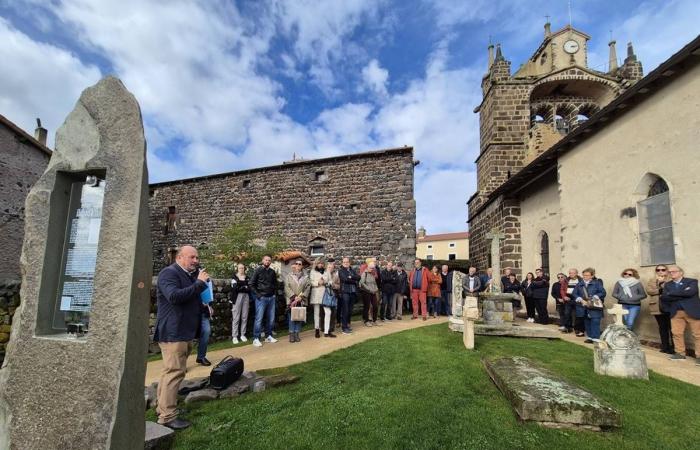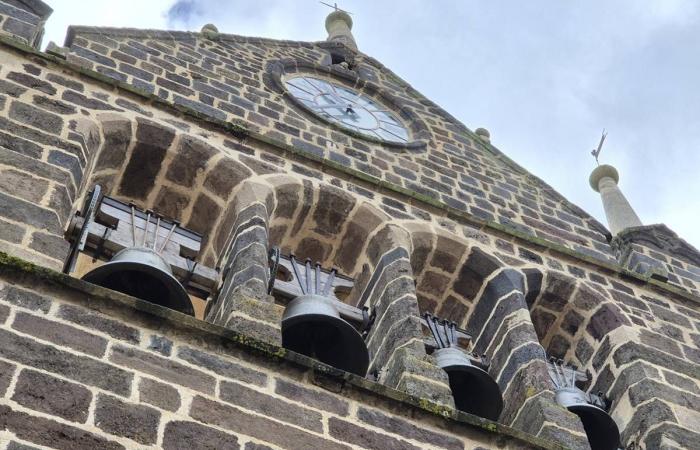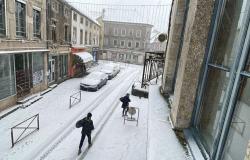The cemeteries around the churches are mostly abandoned. That of Brignon has become a place mixing memory and creativity. Absolutely worth visiting!
“We could make the history of humanity with its tombs.” The words borrowed from Eugène Viollet-le-Duc summarize the unique project, now completed, by a small commune in Haute-Loire (with barely more than 600 inhabitants). This project is to revive, through an old cemetery, a place that bears witness to the past of men and women.
Failing to embrace the history of humanity, the old Brignon cemetery, carefully restored, keeps alive the fire of past centuries on the volcanic plateau. Just a year ago, we visited this cemetery for the first time. It had not been used since the 1920s (a new one having been created very close to here). It has now become a wasteland, if not a dumping ground. Work was therefore undertaken there. A year ago, the developments were still continuing.
“From a walk in a cemetery you emerge stronger”
The restoration was wonderfully orchestrated by the small town and its mayor, Jérôme Bay, without a project manager, but with the desire to honor the deceased and their families, also to highlight a heritage, in particular the Romanesque church (whose existence was revealed by the Medici chronicler as early as 1164), to offer the visitor a place to meditate, facing the splendid Mézenc plateau with the round tower and the Château des Roys in the foreground. Because yes, says Jérôme Bay: “There is nothing macabre about a walk in a cemetery. We always come out stronger.” Paris has Père-Lachaise, named after a priest-confessor of Louis XIV, and Le Brignon, Père-Aulanier. In the 17th century, Father Aulanier, parish priest, kept a logbook for 50 years. He is a local personality. On the right, upon entering the cemetery, the visitor will be able to see the modest tomb of the Aulanier family. The town therefore named the old cemetery after its ardent clergyman.
Free shuttles to access the Puy cemetery for the All Saints’ Day celebrations
A place that bears witness to History, we said. And we must add, creation. The sculptor Pierre Rousseau, a resident of the town, created “Great Witnesses”, sculptures scattered throughout the cemetery, like those he had imagined for the priory of Chamalières-sur-Loire. They are made of stone and safety glass. These five totems offer as many cultural stops describing the landscape, with the mountain, the picturesque gorges of the Loire, the church, the history of the abbot… They also have their symbols, like that of the boat carrying the souls. An allegory often taken up in cemeteries, the place of supreme equality…The mystery of the engraved stone: is it a prior, a monk, or a bishop.
Discreet copper pellets were inserted into the sculptures, in homage to the geologist and historian of Haute-Loire, Jean-Noël Borget, who died too soon (almost a year ago), as the sculptor Pierre Rousseau wished. . Just before his disappearance, Jean-Noël Borget was welcomed by the mayor in the cemetery in order to unravel its mysteries because there is still so much to discover. Jérôme Bay wrote the texts at the heart of the sculptures, which are accompanied by their English tradition provided by John Harris, also residing in the locality. Why look elsewhere for the skills we have locally!
The sculptures are made from a mixture of Blavozy arkose and trachyte, sedimentary and volcanic rocks. Here, all around, basalt is omnipresent. It is recalled on one of the totems “that in the land of volcanic fire”, a vast layer of dark lava covered the light granites two million years ago. Then the Loire carved out a valley. The Gardes du Devès which emerge on the surface of the plateau have long served as a place of observation, hence their name. Basalt is the rock that constitutes the Brignon volcanic plateau. We find it in the composition of the more or less thick slabs constituting certain tombstones which had to be cleaned and which had to find their place inside the cemetery where time had sown incredible disorder.A project that has received a lot of support.
Basalt from the cooling of a lava flow was used to make the crosses where small cavities can be observed, a particularity of volcanic rock (bullous basalt). It also served as a base and support for the metal crosses. The cemetery wall itself is an assembly of small blocks of blacker basalt. After pushing the gate of the small cemetery and before walking through the basalt “chambées” also, taking a path to facilitate discovery, a stone attracts attention. “The great cemeteries under the moon” jealously guard their mysteries. The most modest, like in Brignon, cultivate their own.
The enigma of the carved stone
This stone present inside the church now has its place outside. Jérôme Bay speaks of an “enigmatic” stone. He describes it as follows: “On this basalt slab with broken edges appears a reclining figure, covered in a chasuble and wearing a pallium (a fabric, Editor's note). He is represented with his hands clasped on his upper chest, with a sort of staff, his head covered with a hood. Is he a prior, a monk, a bishop? The question remains unanswered. However, the stick is nothing like a stick. Historians speak of a mysterious stone dating from the 17th century bearing the image of Prior André Séjalon. » The graves reveal the family names of the village. The cemetery closely linked to the Romanesque church
The cemetery closely linked to the Romanesque church
Daniel Veysseyre and the Valley Guards association that he chairs carried out the work of identifying these graves. Among them, those of large, modest families, or that of a viscount. Not all tombstones necessarily correspond to graves, because over the years everything has been mixed up. A certain number of metal and enameled hearts were recovered during the renovation and displayed along the presbytery. “Forty names of people were collected,” indicates Daniel Veysseyre. The last deceased would have been buried in the cemetery in 1925, as evidenced by a plaque found on site. Another tombstone, one of the oldest, is striking with its twin crosses and its reddish tint. It was carved from welded slag. On the surrounding wall, a companion engraved his name and the date of construction in 1660.
The resurrected Brignon cemetery has kept the traces of the ruined lives, of these now unknown people, these “old brothers” as Bernanos called them, “arrived at the gates of the kingdom of God”. In this place, we have a thirst for knowledge, for seeing everything, groping forward as in a detective story, even though, like the author of The Journal of a Country Priest, we know well “what “this return to the past is in vain.” è Visit. On the occasion of the Telethon in the town, a visit to the old cemetery is organized on Saturday December 7 at 2 p.m. The place is also freely accessible from the Brignon church.
Philippe Suc
Visit
On the occasion of the Telethon in the town, a visit to the old cemetery is organized on Saturday December 7 at 2 p.m. The place is also freely accessible from the Brignon church.








